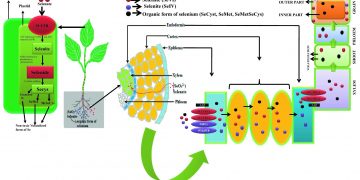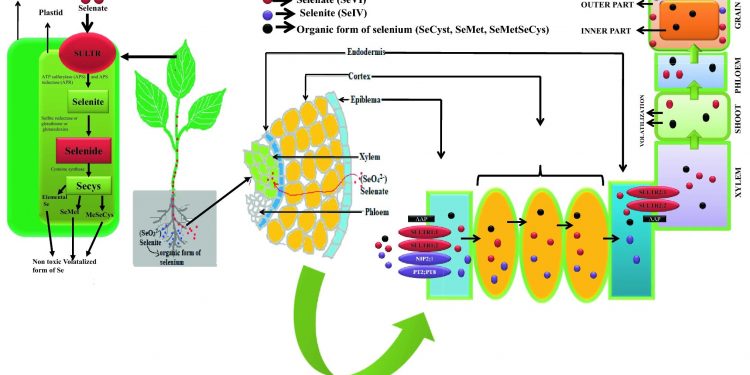A Comprehensive Insight into the Journey of Selenium in Plants: Uptake, Distribution, and Translocation
Selenium (Se) plays a pivotal role in enhancing plant growth and development, yet understanding its uptake, distribution, and translocation mechanisms remains paramount for harnessing its full potential. Figure 1 illustrates the intricate pathways through which different forms of Se navigate within plants, shedding light on its dynamic journey from uptake to accumulation and beyond.
Understanding Se Forms:
In both agricultural and natural environments, selenium exists in diverse forms, including selenate (SeO4^2-), selenite (SeO3^2-), selenide (Se^2-), and elemental Se. Of these, selenate emerges as the predominant inorganic form in agricultural soils, particularly in alkaline conditions, while selenite predominates in acidic soils.
Uptake Mechanisms:
The uptake of Se by plants involves a complex interplay of transporters and channels. Selenate and selenite are absorbed by specific transporters such as SULTR1;1, SULTR1;2, and aquaporins (NIP2;1). Additionally, phosphate transporters PT2 and PT8 facilitate the uptake of selenite. Organic Se species, on the other hand, are assimilated by plant roots via amino acid permease AAP1, enabling their transport to various plant tissues.
Translocation and Distribution:
Once absorbed, Se undergoes translocation within the plant via the xylem and phloem. Transporters like SULTR2;1 and SULTR2;2 play crucial roles in facilitating the movement of Se into shoot cells and loading it into the xylem. Moreover, organic Se species are transported to grains, enriching them with this essential micronutrient. Notably, phloem serves as the conduit for Se transport into seeds, ensuring its deposition in vital plant reproductive structures.
Seed Enrichment:
Observations reveal the presence of diverse Se species across various seed layers, underscoring the significance of efficient translocation and distribution mechanisms in seed enrichment. Through meticulous management of Se uptake and translocation pathways, farmers and agronomists can optimize seed quality and enhance the nutritional value of agricultural produce.
Seizing the Potential:
As global stakeholders in agriculture strive to unlock the transformative potential of selenium in plant nutrition, a nuanced understanding of its uptake, distribution, and translocation dynamics emerges as a cornerstone of sustainable agricultural practices. By leveraging this knowledge, stakeholders can propel the development of innovative solutions aimed at enhancing crop productivity, improving food security, and fostering environmental sustainability.































